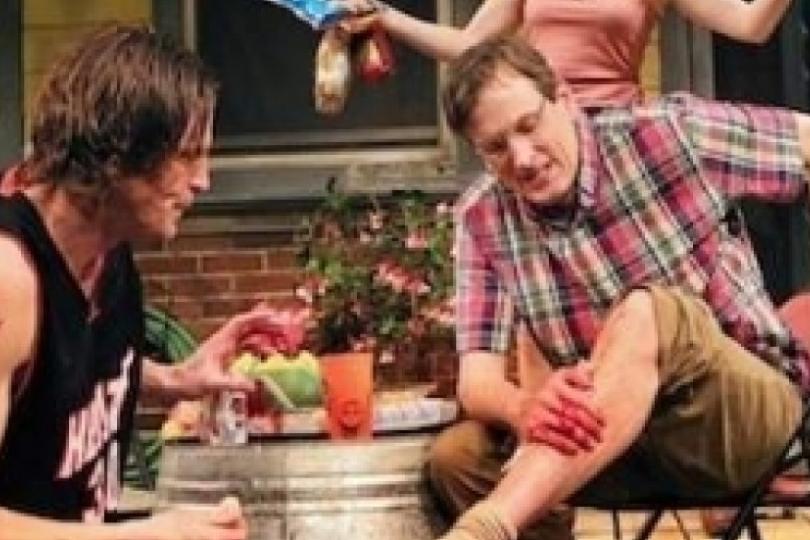Best of 2013-2014: The risks
Editorial

Editor's Note: For the last four years, we've honored the new theater season with a lot back at what made for great work in the past theater season.
Only those who risk going too far can possibly find out how far one can go. — T.S. Eliot
It doesn’t have to be extravagant, garish, or grand, though it can. It requires no trussing up, doesn’t need to point at itself with a winkwink nudgenudge, making sure that we caught its clever risk-ness, its trapeze-artistry. It need not be brilliant or innovative in that blasting I AM BEING INNOVATIVE way; it doesn’t have to be a stunning debut sort of thing. It doesn’t need to exist at the poles of theatricality, the excess and the self-consciously spare.
It does have to be something that stretches, reaches past a limit of some kind, and grasps at more.
Risk, in the performing arts, twists and torques the way we see and understand theater, performance, and probably also the world. It turns old things inside out and rips out the seams. It leans too far out the window, stretches for and sometimes wraps its fingers around a thing beyond. It cants the room a little; the world in our head falls slightly askew.
Risk is what we remember when we leave the theater space—the risks we took in following theater artists into their created worlds, and the risks those artists took themselves. We remember risk because it startles, however lightly, however low, touches our wrist with cold fingers, just barely, or wrenches us out of our chair, out of ourselves.
The best risks are foolish, occasionally insane. They take a moment of insight or instinct that pulled the performer or the watcher out of their usual, daily, low-risk state of feeling and mind. The insight isn’t dug up—it surges up like an unexpected swell of a wave, and we go stumbling backward onto the sand.
Arthur Miller wrote, “The theater is so endlessly fascinating because it is so accidental, so much like life.” You cannot script risk or plan for it or brace for it or even intend its effects—you cannot determine or control its effects anyway, and its impact on others will never be known.
But its impact on others is there whether they know it or not; and its impact on the theater artist has curious power as well. None of us fully knows the extent of risk until we’ve taken it, and stand in the breath-catching aftermath where we consider, sort of reeling, what we did, what was done, what was chanced, gained, lost, won.
Artistic Risk is the little worm that bores a tiny hole in our minds and goes burrowing in, and it can’t be gotten out. It reappears in dreams and at unexpected moments, reminding you that it is there, will always be there in a shared space with you.
Here are a few things that have moved into my head in the last year of Minnesota theater—things I can’t quite describe, can’t quite say what it was that gave me the incomparable sense that a risk had been taken, and something new achieved. This is by no means a comprehensive list; I was not able to see enough. These are simply five creative risks that I will probably never forget. Who can say why? I can’t. They just are.
Best exposure of the underbelly of place: Joel Sass’s creation of the eerie, dark suburbia of Lisa D’Amour’s Detroit at the Jungle Theater. This play also had, inarguably, the most awesome conflagration.
Best all-consuming engagement with a performer: Annie Enneking as Lee Miller in Carson Kreitzer’s Behind the Eye at Park Square Theatre.
Best performance of an insane monologue: Sean Dillon in Winter Miller’s SEED at the Playwrights’ Center.
Best poisonous seduction: Tyson Forbes’ sinewy, barely-articulate, utterly accurate performance of an addict in Detroit.
Best Risk of life and limb: The seated row of movement artists in Wreck who, without glancing behind, threw a man backward over their heads.
In her essay Art Objects, Jeanette Winterson describes a way of watching art—encountering it, engaging with it, consuming it, being consumed. You watch the art. But, too, the art watches you.
We don’t need to understand the risk that we chance upon in the theater. We don’t need to know what’s at stake. We cannot know in advance what it will be, what it will do. There is no preparation. All we can do is listen and watch closely, and wait for the moment when we witness the risk.
We, the audience, have to be willing to take our chances as well. When the art and the artist are leaning out over the precipice, we have to follow them out to the very edge.
Winterson also wrote, “To me, life, for all its privations, is a luminous thing. You have to risk it.”




